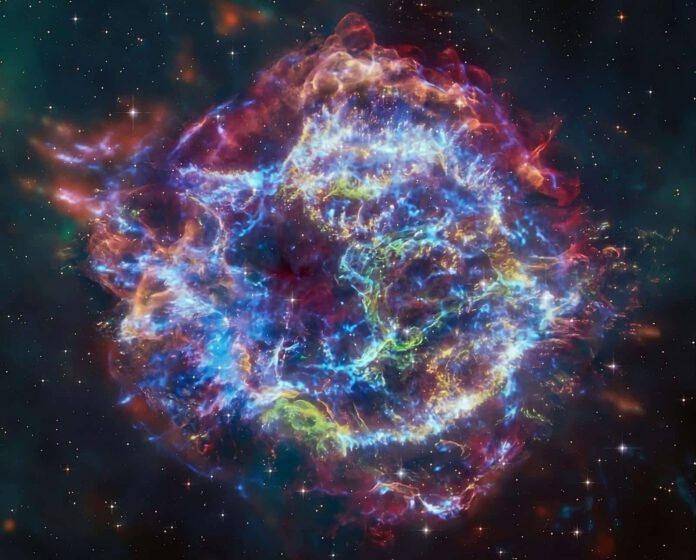
The Supernova Remnant of Cassiopeia A and the ‘Green Monster’
In the supernova remnant of the exploded star Cassiopeia A, there are notable green strands. Scientists have investigated whether this ‘green monster’ came into being before or after the supernova explosion.
Cassiopeia A, or Cas A, lies some 11,000 light-years away in the constellation of Cassiopeia. 340 years ago, a rare supermassive star exploded, though the explosion was not visible to the naked eye from Earth’s surface. The star was surrounded by a considerable amount of gas and dust, leading to its late discovery in 1947. Today, Cassiopeia A is one of the most intensely studied supernova remnants in the universe. Numerous space telescopes have captured images of this cosmic firework-like display. Just earlier this year, the James Webb Space Telescope produced a stunningly detailed image of Cassiopeia A, revealing the green strands in the heart of the supernova remnant for the first time.
The Discovery of the ‘Green Monster’
Now, astronomers have analyzed data from different telescopes, including infrared data from the James Webb Telescope and X-ray data from the Chandra X-ray Observatory. It appears that the green structure existed before the star exploded, and it’s moving in our direction. This structure may have formed from a temporary increase in gas that was blown away from the star.
“So the Green Monster is at the forefront of Cassiopeia A,” explains Jacco Vink from the University of Amsterdam. However, it appears to stand in the middle of the image creating a sort of illusion. The ‘Green Monster,’ makes a photo bomb of the central part of Cas A, adds co-author Ilse De Looze from Ghent University.
The Origin of the ‘Green Monster’ Name
The ‘Green Monster’ in Cassiopeia A is named after the famous eleven-meter-high green wall at Boston Red Sox’s baseball stadium. The 94-meter-long wall has stood since 1912 but was only painted green in 1947. Due to the wall’s height, it is rare for home runs to clear it with many balls bouncing back onto the field.
Significance of the ‘Green Monster’
Scientists are thrilled with the discovery of the ‘Green Monster’s’ origin. Cassiopeia A has become a beloved subject of research. In 2010, astronomers constructed a 3D map of Cassiopeia A, and in 2022, they discovered that part of the material left over after the supernova explosion is moving inwards, not outwards. The nebula is expanding at a rate of between 4,000 to 6,000 kilometers per second and spans sixteen light-years. At the center of the nebula is a dense object, which could either be a black hole or a neutron star.











